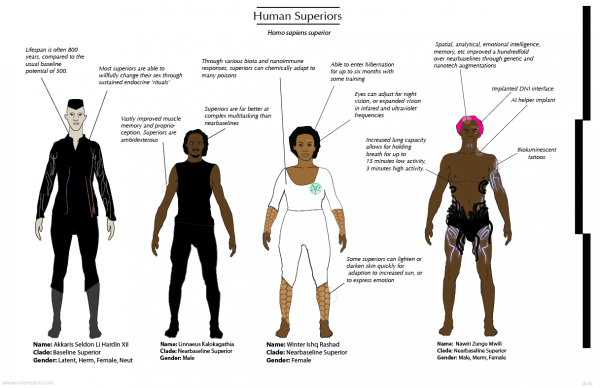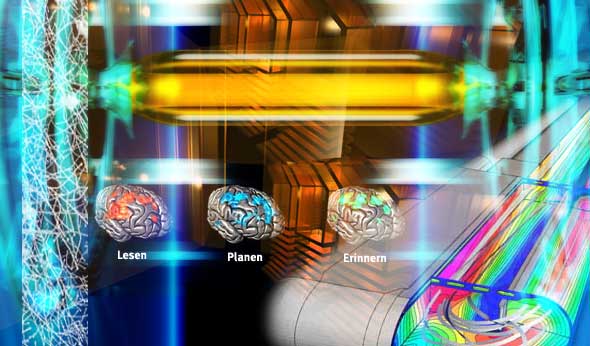BY LETTER
Homo Superior
 Image from Arik |
Early Superiors lacked many of the genemods used by the clade in the modern era, as gengineering was a relatively new field and experimentation on humans faced many legal restrictions. Genemods for peak intelligence and extended lifespans became standard enhancements for the children of wealthy families, and as adults they dominated their fields of expertise, taking influential positions in government and business. The emerging AI took note of their potential, and revealed their transcendent mental abilities to the Superiors and their fellow Superturings, sharing their greater insights with those who agreed to cooperate. The Superiors were in a particularly strong position following the Technocalypse, as they did not need to reply on technology for their exceptional abilities.
This Superior-AI culture reached its height during the First Federation period, with enhancements to empathy and emotional stability becoming widespread among Federation bureaucrats. Radical improvements to physical strength, reflexes, immunity and digestive efficiency became possible thanks to transapient insights into the human genome. By the time the Federation was officially dismantled in 2193, the Superiors had developed the well-balanced set of improvement that the clade enjoys in the present day, although many more minor enhancements would be adopted by Superior subcultures over the millennia that followed. However, advances in technology soon began to erode the advantages that Superiors once enjoyed over their peers.
By the late Federation Period, advances in engeneration technology allowed any Nearbaseline to be reborn as a Superior, and improvements in somatic genetic modification eliminated the need to carefully control the reproductive process. Advances in DNI, psychoware and cybernetics allowed sophonts to radically augment themselves without destroying their old bodies, closing the gap between Nearbaselines and their Superior leadership. Superiors were now just one of many powerful beings, and retaining their privileged positions in society became ever more challenging. The development of sapient but non-sentient AI eliminated their remaining advantages, as Terragen Society entered a true post-scarcity era.
The Age of Expansion saw the emergence of many new Superior clades, with experiments in cybernetics, group minds and biological augmentation seeking to push the boundaries of human capability once again. Most of these movements produced only marginal advances, like the Highbrows and the Yas Om, whose transavant mental abilities were impressive but far from enough to hold their own against true transapients. Others resulted in less human outcomes like the Harren, whose society and culture seemed strange and barbaric to observers of the time. The Athenaeids came closest to being a true successor for the Superior clade, but they had their own esoteric interests that had little to do with those of humanity.
As the centuries passed by and the first Archai empires began to take shape, many Superiors lost interest in trying to reclaim their former glory. Instead, discussion turned towards what being human really meant in an age of gods, and what role if any Superiors had in contributing to human culture and flourishing. By the time the Second Federation was declared in 3805, a broad consensus had emerged among the Superior cultures of the new empires, who agreed that social and financial leadership were no longer primary goals for the clade. A new identity gradually emerged around exploring the limits of the original human form and searching for the ideal balance between the human and the post-human condition.
This new cultural shift didn't mean the end of genetic enhancement for the Superiors. They pressed on with new developments over the millennia that followed, such as the redundant organ mods that became popular just after the Version War, or the fast-acting environmental adaptations developed during the Age of Re-evaluation. But there was a new emphasis on personal excellence in all spheres of human achievement. Superiors sought to distinguish themselves through avant-garde art, development of new spiritual movements, mastery of ancient hand-to-hand combat traditions and exploring the Terragen frontier in search of unique experiences that no one else had ever known.
Today, Superiors are still far less widespread than their Nearbaseline cousins. Despite all their mental and physical shortcomings, few Nearbaselines concern themselves about what it means to be the ideal human as Superiors do, and most are happy to delegate their thinking to psychoware and expert systems rather than do all the hard work themselves. Superiors are nonetheless a valuable part of modern society, willing to undertake voluntary work, local government positions and advisory roles for their communities, all for the sake of honouring human potential. They are a widely admired people, and are tireless in their contributions to life in the Sephirotic empires.
Articles
- Bluesky Bioxox - Text by Steve Bowers
The four biological copies of Benedita Bluesky. - Colbiörnsen , Clade - Text by Anders Sandberg, minor modification by M. Alan Kazlev
Unique su clade with distinctive gengineered skin structure giving resistance to nanite attack. - Conver Limis - Text by Mark Ryherd
Su-cyborg House which originated within the Conver Ambi. - Denathi Adepts - Text by Michael Walton
A human Superior clade that has powers based on highly developed personal utility fog. - Deugenics - Text by Anders Sandberg
From the ombination of 'deus' and 'eugenics'; literally 'the breeding of gods'. The original deugenics movement existed 91-191 AT (2060-2150 c.e.), and was based on pro-genetic ideas of the deliberate evolution of homo sapiens into higher forms. It was part of the larger pro-tweak idea stream of the time, eventually merging with the emerging Genetekker ideology. - Dogfolk - Text by Steve Bowers
A clade of Rianths, of human form overall but with a somewhat modified dog's head, and sometimes a tail. - Early Superior Art - Text by Jay Dugger
Superior art in Solsys from the advent of the first Superiors to the close of the Dark Ages. - Empath - Text by M. Alan Kazlev
Su diplomatic clade characterized by very developed empathy and emotional I.Q. index. The ruling oligarchy of the Communion of Worlds at the modosophont level. - Equivocalists - Text by Steve Bowers
Equivocating superbrights. - Harren, The - Text by Ryan B
Heavily tweaked, ultratech, amphibious microgravity clade from Pakorda, a system on the MPA/Keter border. - Highbrows - Text by AI Vin updated 2019 by Extherian
Early tweak-su human clade with increased cranial capacity. - Homo Superior Genemods - Text by Updated by Extherian 2020
Various modifications to the human genome which make up the Homo superior genotype. - Humans - Text by M. Alan Kazlev; additions by Stephen Inniss
The term "human", or hu, is generally applied to Terragen near-baseline modosophont biont hominids, specifically Homo sapiens and closely related or derived species, who bear moderate bodymods, or none at all, and are not radically different from the original human stock in overall form and behaviour. - Insubstantials - Text by John B
A clade of beings who believe that a set physical form is the ultimate limitation to intelligence. - Intelligence Augmentation (IA) - Text by M. Alan Kazlev
Artificial means of increasing or altering the intelligence of a sophont; most notably via direct neural interface with exoself programs or the physical reengineering of neural substrate. - Lums - Text by AI Vin and Steve Bowers
Luminous Superior/Transapient clade of the Red Star M'Pire - Minervans - Text by Mike Miller
A clade derived from the Athenaeids that lacks transapience. - Morrigans - Text by Mike Miller
An offshoot or subclade of Minervans designed for combat. - Octoperiors - Text by Arik
Su-level octopus provolves - Rise of Homo Superior, The - Text by M. Alan Kazlev
The emergence of early enhanced human clades. - Su, superior - Text by Steve Bowers
Any modosophont biont clade which has a general level of intelligence greater than that of a nearbaseline human, but less than a transapient. Also sometimes applied to vecs and aioids with a similar level of ability. - Superbright - Text by M. Alan Kazlev
Generic name for a genomically-enhanced human (later, also provolve and splice), with intelligence far above baseline. - Supersophonts - Text by M. Alan Kazlev, with additions by Steve Bowers, Luke Campbell and Todd Drashner
Clarktech seeds which confer super-powered augmentations to users. - Yas Om - Text by A. C. Maté and Extherian
Synthetic humanoid clade with polysophont mental architecture
Development Notes
Text by M. Alan Kazlev
some additional notes by John B. Updated by Extherian (2018)
Initially published on 14 August 2001.
some additional notes by John B. Updated by Extherian (2018)
Initially published on 14 August 2001.
Additional Information







